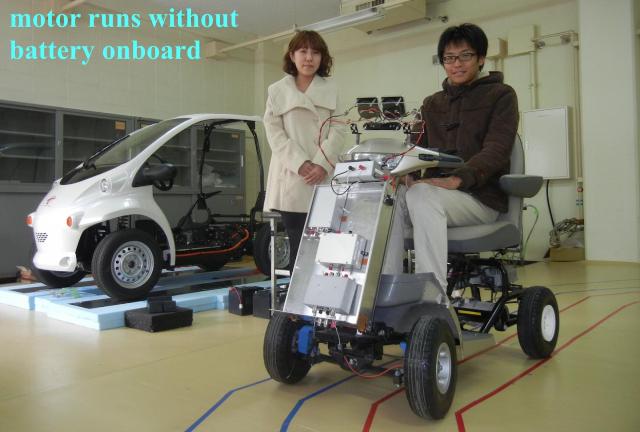Oct 9 2015
Wireless power transfer has many promising applications, such as contactless powering, electric vehicles, and energy harvesting. To construct a wireless power-transfer system, a "wireless transfer coupler" is necessary to deliver the energy from a high-frequency power source to a load, with no physical contact.
 Wireless power enables the electric vehicle to run without batteries onboard: This vehicle's wheels are powered by electric rails beneath the road. A miracle has come true, thanks to Ohira's kQ theory. (COPYRIGHT (C) 2015 TOYOHASHI UNIVERSITY OF TECHNOLOGY. ALL RIGHTS RESERVED.)
Wireless power enables the electric vehicle to run without batteries onboard: This vehicle's wheels are powered by electric rails beneath the road. A miracle has come true, thanks to Ohira's kQ theory. (COPYRIGHT (C) 2015 TOYOHASHI UNIVERSITY OF TECHNOLOGY. ALL RIGHTS RESERVED.)
In the past, "coupling coefficient k" was used as an index of wireless-power-transfer efficiency. Since k decreased as the power-transfer distance increased, it was believed that the transmission efficiency would decline. In 2007, however, it was found that the transfer potential could increase, even over large distances, if the Q factor (quality factor) was high.
Now, Professor Takashi Ohira, Director of the Research Center for Future Vehicle City at Toyohashi University of Technology, in cooperation with the Anritsu Corporation, has made it possible to measure the kQ product in real-time, based on Ohira's kQ theory. This software is installed in the ShockLine-series Vector Network Analyzers, models MS461xxA, MS463xxA, and MS465xxB.
"A function to simultaneously estimate and display the ηmax (maximum efficiency, see Reference 3) of a wireless transfer link from the kQ product using tan θ (the efficiency tangent) has also been realized," explains Professor Ohira. "Using this newly developed measurement system, it is possible to greatly improve prototypes and design high-efficiency couplers for wireless power transfers."
This system contributes to the construction of highly efficient wireless power-transfer systems by enabling the following.
- Finding the maximum transmission efficiency by changing (scanning) the power transmission and reception positions.
- Improving development speeds through the quick discovery of structures and dimensions.
- Rapidly discovering the dependency of the optimum transmission frequency on structural parameters.
This newly developed "kQ measurement system" will accelerate the realization of various wireless power-transfer applications in our everyday lives; for example, contactless powering of home applications, battery-free electric vehicles, and energy harvesting.